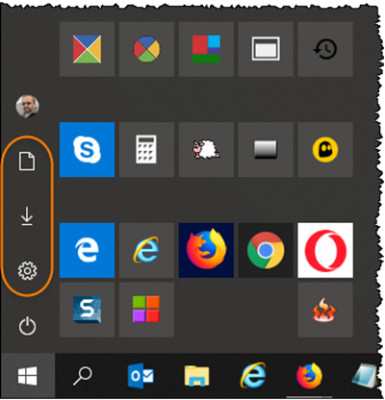
- #Windows 10 start menu folder user windows 10
- #Windows 10 start menu folder user password
- #Windows 10 start menu folder user Pc
- #Windows 10 start menu folder user windows
#Windows 10 start menu folder user windows
This location is the Windows Task Manager. You can only enable or disable those currently inside of the Startup folder. The only difference is that programs cannot be added or removed. There is one area that enables you to interact with the Startup function, which contains all of the programs found inside of the folder. Attempting to understand why a certain application isn’t opening, or when working with applications that feature user-based licensing or access restrictions will require you know which Startup Folder to configure. Understanding the distinction between the All Users and Current User Startup Folders is important when it comes to troubleshooting. Each account will contain a unique Startup Folder in addition to the universal Startup Folder.
#Windows 10 start menu folder user windows 10
The second one only really matters if you have multiple accounts on your Windows 10 computer. One Windows 10 Startup folder operates at the system level and is shared among all user accounts (All Users folder), while the other operates at a user level and is unique to that user’s account (Current User folder).
#Windows 10 start menu folder user Pc
To move your personal files from your old account to your new account, try opening File Explorer, expanding This PC > OSDisk (C:), and looking in the Users folder, where you should see folders for both accounts. You can then copy and paste your files from the old account folder to similar locations in the new account folder. Or if you prefer, you can upload your files from your old account to OneDrive, and then sign into the new account and download the files from OneDrive.When it comes to the Windows 10 Startup folder, it can be found in two different locations. Under Your family (or Other users, if you're using Windows 10 Enterprise), choose the account you created, and then select Change account type. In Settings, select Accounts, then select Family & other users.
#Windows 10 start menu folder user password
Set a user name, password, and password hint. On Windows 10 Enterprise, select I don’t have this person’s sign-in information, and then select Add a user without a Microsoft account. On Windows 10 Home and Windows 10 Professional, provide a name for the user and a password, and then select Next. Under Other users, select Add someone else to this PC. In Settings, select Accounts > Family & other users (or Other users, if you’re using Windows 10 Enterprise). Type your Microsoft account password and select Next.Ĭhoose a new account name, password, and password hint, then select Finish and sign out. Select Sign in with a local account instead. You'll see this link only if you're using a Microsoft account, and you may not see it if your device is on a network. In Settings, select Accounts > Your info (in some versions, it may be under Email & accounts instead). One could move a shortcut from All Users to Owner. If you're signed in with your Microsoft account, remove the link to that account first by doing the following (if that's not how you're signed in, skip to creating a new administrator account): In previous versions of Windows, Explorer allowed access to the Start Menu folders for All Users, Owner, Guest User, etc. If you still can’t fix your problem with the Start menu, try creating a new local administrator account. If the problem still isn't fixed, try deleting your old administrator account To move your personal files from your old account to your new account, try opening File Explorer, expanding This PC, selecting OSDisk (C:), and looking in the Users folder, where you should see folders for both accounts. You can then copy and paste your files from the old account folder to similar locations in the new account folder. Or if you prefer, you can upload your files from your old account to OneDrive, and then sign into the new account and download the files from OneDrive. If everything is fixed, move your personal data and files to the new account. Sign out of your account and then sign in to your new account. Under Account type, select Administrator > OK.

Under Family & other people (or Other users, if you're using Windows 11 Enterprise), choose the account you created, and then select Change account type. Make the new account an administrator account Provide the requested info and follow the prompts to create the account. Under Other users, select Add someone else to this PC or Add account. Select Accounts > Family & other people (or Other users, if you’re using Windows 11 Enterprise). If you aren't using an administrator account and you don't have one, you can create an account and set it as an administrator account. If you see "Administrator" near your name, then you're using an administrator account.

To see which account you're signed in with: If you still can’t fix your problem with the Start menu, try signing in with an administrator account.


 0 kommentar(er)
0 kommentar(er)
